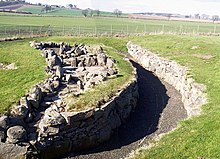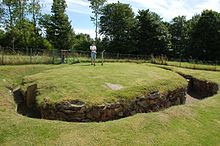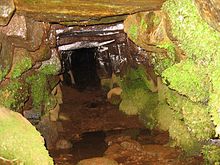Basement in Scotland
The Souterrains in Scotland form, as E. T. Wainwright stated in 1853, no morphologically homogeneous group within the complex prehistoric buildings. Souterrains that differ more regionally and have been adequately investigated exist in Aberdeenshire , Angus , Sutherland and Orkney .
distribution
The Scottish basement area is, with twelve exceptions, north of the River Tay . Their distribution is uneven. While Angus, Aberdeenshire and Sutherland (40) have large clusters, other areas are nearly empty. Basement areas are almost completely absent in southwestern Scotland and the western highlands . One of the few in the area, Ardeer Souterrain in Ayrshire , is a chimera . The dry stone corridor covered with slabs leads into a natural cave.
Southern Pictland
Considerable basements come from the counties of Angus , Perth and Fife , that part of the country, which is also called "southern Pictland ". These basements consist of a long curved, usually paved, corridor and a narrower entrance. The structures have widths up to 2.45 m and an average height of 1.83 m. The length of the buildings was only determined in nine places. They vary from 12.2 m (Mudhall) to 39.6 m ( Carlungie 1 ). According to Gordon Barclay there are 57 basements in the Southern Pictland.
Ceiling design
There was a debate about the often undetectable coverage of the basement. MacRitchie argued for wooden roofs. Wainwright suggested massive stone roofs. Wainwright refuted and also suggested wooden roofs. At least Hurly Hawkin , a basement of this group discovered in Angus, has a roof made of flagstones.
Floor finish
The basement of the southern Pict country is simply structured. High standard paving have been registered with Carlungie 2, Newmill, Hurly Hawkin and Longforgan. A stone drainpipe was excavated at Ardestie in Angus. However, drainage pipes are not standard equipment in the basement of Angus. Indeed, the Ardestie drainpipe was a secondary installation.
Others
Barriers, as they are normal in Ireland, are not part of the standard of the group in the Southern Pict country, although posts have been registered at Tealing 3 . Cup stones from the Bronze Age are used in the construction of this group's basement, for example in Ruthven, Tealing 3 and Hurly Hawkin. been used. The basement of West Grange of Conan , like the basement of Tigh Talamhain on Skye, has a chamber in the form of a beehive hut, which is atypical for the group . The best parallel of these chambers is Castlelaw in Midlothian in Scotland .
The northern islands
The Orkney examples form a particular group, probably reflecting a quirk dating from about 600 BC. Existed until the early centuries AD. The basement essentially consists of a comparatively short corridor and a not very large oval room. In contrast to the earth houses in Angus and Perthshire , whose roofs protrude from the ground level, the orcadian (earth-cut) examples are lower, while the harder to manufacture (rock-cut) examples are naturally higher.
About 25 earth houses are known on the Orkney, mostly on Mainland , but also on Eday , Hoy and Rousay . Only five (including Corrigall and Windwick ) have been excavated in recent years, and most of the information is from 19th century discoveries. Grain Earth House , on the outskirts of Kirkwall, was discovered in 1827 but was not examined by Farrer and Petrie until 1857. It was so well preserved that in 1908 it was placed under protection as a typical example of an Orkadian earth house as the earliest monument on Orkney. No useful record of the excavation was made, but it is clear that the chamber was empty and the surface above bears traces of settlement. There were walls that ran in different directions and a large pit with waste material. The pit may have been part of another earth house, as during an excavation in 1982 parts of two other earth houses were found next to the earth house, again with traces of a surface settlement. One earth house seemed to follow another in time, but it was not possible to completely excavate them. This combination is particularly common in Ireland, with the round above-ground part taking on the dimensions of a dun or a rath. The Grain earth house has a depth of 3.7 m in the chamber area, with about two meters of floor above the roof. This great depth seems to be related to geology. The builders dug down to the natural ground. Because of the depth, steps in grain were required to reach the level of the corridor. Elsewhere, a hatch creates direct access to the corridor. In the Grain Chamber it is possible to stand almost upright in the room, whereas the approach through the corridor has to be stooped. Usually the roof of the corridor consists of horizontal panels. The Grain chamber ceiling, like that of other Orcadian examples, is formed from a combination of corbels and stone pillars. At Midhouse on Orkney, the roof is supported by seven pillars and an irregularly shaped rock. Where the columns were insufficiently high, plates were placed in order to achieve the required height.
Several old reports mention piles of trash filling the entrance to the earth house, and modern excavations have found backfills as well. A special aspect of the Rennibister basement is the discovery of skeletal material on the chamber floor. The bones are from six adults and twelve children of different ages. There were no artifacts indicating the age of the bones. Since they are not in the bone structure, they must have been deposited as bones and not as bodies. Howe earth houses near Stromness and Rowiegar on Rousay were built within older megalithic structures.
On the Shetland Islands, too, the chambers have roof structures made up of a cantilever vault supported by free-standing columns. Similar ceilings have z. B. also the basements of Roovesmore and Carhoovauler in County Cork in Ireland . Other examples of pillar-supported chamber roofs on Orkney include Biggings, Dale, Grain, and Hatston. A basement at Jarlshof in the Shetlands contained a chamber, the roof of which was supported by four pillars. A relatively normal basement covered with slabs and with recent research is the Windwick basement . The entrances to the basement of the Orkney and Shetland groups are narrow, their chambers claustrophobically narrow. A new intact basement was discovered in 2007 at Carrigal in Harray on Mainland.
The western islands
The basement of the islands of western Scotland ( Arnabost , Greenhill , Kilkenneth ) are extremely different in shape. Generally they are low, narrow, and small. Some, for example Usinish in the Hebrides , were attached to wheelhouses . The research work on the basement of this group is still little developed.
Sutherland
In Sutherland, in addition to simple corridors that sometimes lead to a round or oval chamber, there are also cross-shaped complexes ( Kirkton ). The basement of this group generally consists of an undifferentiated passage chamber area. Chamber and passages have wide connections. The basement of Salscraggie was entered by a flight of steps. The basement of Rosal shows a stepped ramp access, which leads to an undifferentiated corridor-chamber structure of about 12.8 m in length. The entrance to the chamber is 0.61 m wide. There two posts had been set in front of the walls of the corridor. Their vertically protruding profile is in contrast to the otherwise horizontal masonry. The low ceiling lintel lies above the post. The chamber has a ceiling made of panels that are occasionally supported by posts. The basement of Portnacon contained a cavity 1.22 m in diameter and about 0.61 m deep. Buxten assumes that it is a cesspool (the basement seems to have suffered from water ingress). At Cyderhall , the presence of paired post holes and the absence of flat stones indicate a former wooden roof.
Aberdeenshire
The Aberdeenshire Group's basements appear to have ties to both Sutherland and southern Pictland. However, they are considerably smaller than the latter. Wainwright drew attention to the Glenkindie basement, which is more chamber-oriented than corridor-oriented. Its two roughly oval rooms connected by a hatch are atypical for the group.
function
The function of the Scottish basement has not yet been finally discussed. While most archaeologists would like to provide the structures in the north and west of Scotland with a shelter function, this is not seen in the case of the basements in the southern Pictland. Wainwright's idea of interpreting the large, curved, paved rooms as cattle sheds is not shared by later archaeologists who argue in favor of a warehouse function. (See, however, Cornwall .) The basement alone usually provides no clues. Many basements are located within forts or in an area of round huts and their entrances are within one of these huts. The excavation of the Windwick basement also provided new insights . "Stone spheres" (Petrospheres) found in basements, such as that at "Jock's Thorn Farm" in Kilmaurs, East Ayrshire , may have been symbols of power in prehistoric societies. Their discovery in basement suggests a different use than that of storing food and resources.
Dating
There are many unresolved issues in basing basement dating in Scotland. Vere Gordon Childe and Curle argued for a Bronze Age origin of some examples in the far north. Thomas thinks that it is difficult to prove that the basements were in use in some regional groups before the late pre-Roman Iron Age. This was justified by the fact that the basements of Newstead in Roxburgh and Crighton Mains in Midlothian contained stones that come from abandoned Roman facilities. The majority of the systems in the southern Pictorial Zone were dated between 50 and 250 AD. A number of subterranean structures with obvious resemblance to basements have been uncovered at Dalladies, Kincardineshire. Scientific dating shows that it was used between the 3rd century BC. Several of these basements, should they be accepted as such, contained wooden structures that likely represent roof supports. One of the underground structures has a ramp access and weak evidence of a doorway.
The Ardross basement in Fife is typical of the dating debate. Wainwright stated that this basement, although located in Fife, had no morphological connections to the structures in southern Pictland. Basically, the basement consists of a corridor 18.3 m long, which leads to a sub-rectangular room. The entrance shows an escape of ten well-built steps. The corridor contained a pair of door stones that reduced the width of the passage to the chamber to 0.56 m. The connection of the corridor with the chamber is marked by three descending steps. The combination of these properties led Wainwright to the thesis that this basement was built by colonists who came from the northern islands. However, this basement could not be dated.
literature
- Gordon Barclay: Newmill and the 'souterrains of southern Pictland'. Contribution to: Trevor Watkins: Excavation of a settlement and souterrain at Newmill, near Bankfoot, Perthshire. In: Proceedings of the Society of Antiquaries of Scotland. Vol. 110, 1978/1980, ISSN 0081-1564 , pp. 165-208 , here pp. 200 ff.
- Mark Clinton: The Souterrains of Ireland. Wordwell, Bray Co. Wicklow 2001, ISBN 1-869857-49-6 , pp. 175 ff.
- John Hunter: Excavation at Ardeer, Ayrshire. In: Proceedings of the Society of Antiquaries of Scotland. Vol. 105, 1972/1974, pp. 296-301 .
- David B. Taylor: Excavation of a promontory fort, broch and souterrains at Hurly Hawkin Angus. In: Proceedings of the Society of Antiquaries of Scotland. Vol. 112, 1982, pp. 215-253 .
- Charles Thomas: Britain and Ireland in early Times. AD 400-800. Thames and Hudson, London 1971, ISBN 0-500-56002-1 .
- Frederick T. Wainwright: Souterrains in Scotland. In: Antiquity. Vol. 27, No. 108, 1953, ISSN 0003-598X , pp. 219-232, doi : 10.1017 / S0003598X00025084 .
- Frederick T. Wainwright: A basement identified in Angus. In: The Antiquaries Journal. Vol. 33, No. 1/2, 1953, ISSN 0003-5815 , pp. 65-71, doi : 10.1017 / S000358150005887X .
- Frederick T. Wainwright: A souterrain at Longforgan in Perthshire. In: Proceedings of the Society of Antiquaries of Scotland. Vol. 88, 1955/1956, pp. 57-64 .
- Frederick T. Wainwright: Houses and graves. In: Frederick T. Wainwright (Ed.): The problem of the Picts. Nelson, Edinburgh et al. 1955, pp. 87-96.
- Frederick T. Wainwright: The souterrains of southern Pictland. Routledge & Paul, London 1963.
- Trevor Watkins: Excavation of a settlement and souterrain at Newmill, near Bankfoot, Pertshire. In: Proceedings of the Society of Antiquaries of Scotland. Vol. 110, 1978/1980, pp. 165-208 .
Individual evidence
- ^ Wainwright: Basement in Scotland. In: Antiquity. Vol. 27, No. 108, 1953, pp. 219-232, here p. 219.
- ^ A b Wainwright: The souterrains of southern Pictland. 1963, p. 3.
- ^ Thomas: Britain and Ireland in early Times. AD 400-800. 1971, p. 45.
- ↑ Hunter: Excavation at Ardeer, Ayrshire. In: Proceedings of the Society of Antiquaries of Scotland. Vol. 105, 1972/1974, pp. 296-301.
- ^ Wainwright: Basement in Scotland. In: Antiquity. Vol. 27, No. 108, 1953, pp. 219-232, here p. 221.
- ^ Barclay: Newmill and the 'souterrains of southern Pictland'. Contribution to: Trevor Watkins: Excavation of a settlement and souterrain at Newmill, near Bankfoot, Perthshire. In: Proceedings of the Society of Antiquaries of Scotland. Vol. 110, 1978/1980, pp. 165-208, here p. 202.
- ^ Wainwright: The souterrains of southern Pictland. 1963, p. 156.
- ^ Barclay: Newmill and the 'souterrains of southern Pictland'. Contribution to: Trevor Watkins: Excavation of a settlement and souterrain at Newmill, near Bankfoot, Perthshire. In: Proceedings of the Society of Antiquaries of Scotland. Vol. 110, 1978/1980, pp. 165-208, here p. 204.
- ↑ a b Taylor: Excavation of a promontory fort, broch and souterrains at Hurly Hawkin Angus. In: Proceedings of the Society of Antiquaries of Scotland. Vol. 112, 1982, pp. 215-253, here p. 215.
- ^ Wainwright: A basement identified in Angus. In: The Antiquaries Journal. Vol. 33, No. 1/2, 1953, pp. 65-71, here p. 65.
- ^ Watkins: Excavation of a settlement and souterrain at Newmill, near Bankfoot, Pertshire. In: Proceedings of the Society of Antiquaries of Scotland. Vol. 110, 1978/1980, pp. 165-208, here p. 205.
- ^ Wainwright: A souterrain at Longforgan in Perthshire. In: Proceedings of the Society of Antiquaries of Scotland. Vol. 88, 1955/1956, pp. 57-64.
- ^ Wainwright: The souterrains of southern Pictland. 1963, p. 58.
- ^ Wainwright: Basement in Scotland. In: Antiquity. Vol. 27, No. 108, 1953, pp. 219-232, here p. 220.
- ^ Wainwright: The souterrains of southern Pictland. 1963, p. 210.
- ↑ Taylor: Excavation of a promontory fort, broch and souterrains at Hurly Hawkin Angus. In: Proceedings of the Society of Antiquaries of Scotland. Vol. 112, 1982, pp. 215-253, here p. 223.
- ^ Vere Gordon Childe : Excavations at Castlelaw Fort, Midlothian. In: Proceedings of the Society of Antiquaries of Scotland. Vol. 67, 1932/1933, pp. 362-388 .
- ^ J. Hewat Craw: An Underground Building at Midhouse, Orkney; Two Urns found at Lintlaw, Berwickshire; and the Excavation of a Cairn at Drumelzier, Peeblesshire. In: Proceedings of the Society of Antiquaries of Scotland. Vol. 65, 1930/1931, pp. 357-372 .
- ^ Stuart Piggott: Scotland before History. Edinburgh University Press, Edinburgh 1982, ISBN 0-85224-348-0 , p. 154.
- ↑ Alexander O. Curle: Account of the Excavation of a Hut-Circle with an associated Earth-House at Jarlshof, Sumburgh, Shetland, conducted on behalf of the HM Office of Works in 1935. In: Proceedings of the Society of Antiquaries of Scotland. Vol. 110, 1935/1936, pp. 237-251 , here p. 241.
- ↑ Sigurd Towrie: Archeologists descend on Harray earth-house . 2007. On orkneyjar.com.
- ^ Wainwright: Basement in Scotland. In: Antiquity. Vol. 27, No. 108, 1953, pp. 219-232, here p. 223.
- ^ A b Wainwright: Souterrains in Scotland. In: Antiquity. Vol. 27, No. 108, 1953, pp. 219-232, here p. 226.
- ↑ John Corcoran XWP: The Basement at Rosal, Strathnaver, Sutherland. In: Proceedings of the Society of Antiquaries of Scotland. Vol. 100, 1967/1968, pp. 114-118 .
- ^ RJ Buxton: Earth-house at Portnacon, Sutherland. In: Proceedings of the Society of Antiquaries of Scotland. Vol. 69, 1934/1935, pp. 431-433 , here p. 433.
- ^ Robert W. Pollock: The excavation of a souterrain and roundhouse at Cyderhall, Sutherland. In: Proceedings of the Society of Antiquaries of Scotland. Vol. 122, 1992, pp. 149-160 .
- ^ Wainwright: The souterrains of southern Pictland. 1963, p. 122.
- ^ V. Gordon Childe: The Prehistory of Scotland. Kegan Paul, Trench, Trubner & Co., London 1935, p. 212.
- ↑ Alexander O. Curle: An Account of the Excavation, on behalf of the HM Office of Works, of another Prehistoric Dwelling (No. V.) at Jarlshof, Sumburgh, Shetland, in the Summer of 1934. In: Proceedings of the Society of Antiquaries of Scotland. Vol. 69, 1934/1935, pp. 85-107 , here p. 106.
- ^ Thomas: Britain and Ireland in early Times. AD 400-800. 1971, p. 76.
- ^ Stuart Piggott: Scotland before History. Edinburgh University Press, Edinburgh 1982, ISBN 0-85224-348-0 , p. 141.
- ^ Wainwright: The souterrains of southern Pictland. 1963, p. 24.
- ^ Trevor Watkins: Excavation of an Iron Age open settlement at Dalladies, Kincardineshire. In: Proceedings of the Society of Antiquaries of Scotland. Vol. 110, 1978/1980, pp. 122-164 .
- ^ G. Wainwright: The basements of southern Pictland. 1963, p. 162.


